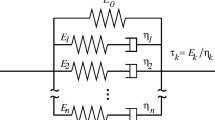Abstract
Signal processing problems arising in the study of the linearly viscoelastic behavior of polymers and composites are considered. It is shown that the great amount of data conversions is associated with integral transforms using kernels which depend on the ratio or product of arguments for monotonic long-time-interval and wide-frequency-band functions (signals). A unified method of carrying out these integral transforms is developed by combining a logarithmic transformation of the signal time scale with digital filtering. For integral transforms leading to ill-conditioned inverse problems, a method of regularization is proposed based on choosing a sampling rate which ensures an acceptable error variance of the output signal. The specific features of the functional filters used for performing the functional (integral) transforms are discussed. Examples of performing the Heaviside-Carson sine transform and an inherently ill-conditioned problem of inverting the integral transform for determining the relaxation spectrum are represented by digital functional filters.
Similar content being viewed by others
REFERENCES
J.D. Ferry, Viscoelastic Properties of Polymers, Wiley, NJ (1961).
N.G. McCrum, B. E. Read, and G. Williams, Anelastic and Dielectric Effects in Polymer Solids, Wiley, London (1967).
C.J. Gorter, Paramagnetic Relaxation, Elsevier, Amsterdam (1947).
V. Shtrauss, “Information processing technology in the study of relaxation phenomena. Review,” Automat. Control Comput. Sci., 28, No. 3, 156-161. (1995).
S.B. Dev, A. M. North, and R. A Petrick, “Computational techniques in the analysis of dielectric relaxation measurements,” Adv. Mol. Relax. Processes, 4, No. 2, 159-191 (1972).
F.R. Schwarzl, “The numerical calculation of storage and loss compliance from creep data of linear viscoelastic materials,” Rheol. Acta, H. 1, Bd. 8, 6-17 (1969).
L.C. E. Struik and F. R. Schwarzl, “Conversion of dynamic into transient properties and vice versa,” Rheol. Acta, H. 2, Bd. 8, 134-141 (1969).
P.J. Hyde, “Wide-frequency-range dielectric spectrometer,” Proc. IEE, 117, No. 9, 1891-1901 (1970).
F.C. Roesler and J. R. A. Pearson, “Determination of relaxation spectra from damping measurements,” Proc. Phys. Soc., 67, pt. 4, No. 412B, 338-347 (1954).
F.C. Roesler, “Some applications of Fourier series in the numerical treatment of linear behaviour,” Proc. Phys. Soc., 68, Pt. 2, No. 422B, 89-96 (1955).
L.R. Rabiner and B. Gould, Theory and Application of Digital Signal Processing, Prentice-Hall, Englewood Cliffs, New Jersey (1975).
V. Cappellini and A. G. Constantinides, Digital Filters and Their Applications, Academic Press, London (1978).
V. Shtrauss, “Sampling relaxation signals,” Automat. Control Comput. Sci., 30, No. 2, 28-36 (1996).
V. Shtrauss, “Functional conversion of signals in the study of relaxation phenomena,” Signal Processing, 45, No. 3, 293-312 (1995).
V. Shtrauss, “Sampling in accomplishing functional transforms by digital filters,” in: Proceedings of 1999 International Workshop on Sampling Theory and Applications SAMPTA'99. August 11-14, 1999, Loen (1999), pp. 168-202.
A.N. Tikhonov and V. Y. Arsenin, Solution of Ill-posed Problems, V. H. Winston, Washington DC (1977).
V. Shtrauss, “Spectrum analysis and synthesis of relaxation signals,” Signal Processing, 63, 107-119 (1997).
S. Havriliak and S. Negami, “A complex plane representation of dielectric and mechanical relaxation processes in some polymers,” Polymer, 8, No. 4, 161-210 (1967).
K.S. Cole and R. H. Cole, “Dispersion and absorption in dielectric. Alternating current characteristics,” J. Chem. Phys., 9, No. 4, 341-351 (1941).
Author information
Authors and Affiliations
Rights and permissions
About this article
Cite this article
Shtrauss, V. Signal Processing in Relaxation Experiments. Mechanics of Composite Materials 38, 73–88 (2002). https://doi.org/10.1023/A:1014065008628
Issue Date:
DOI: https://doi.org/10.1023/A:1014065008628




